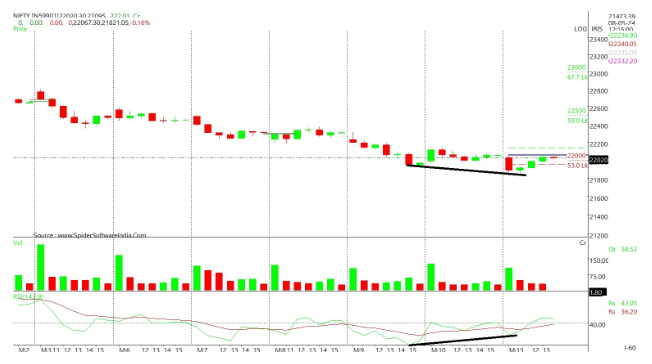
In what seemed like a harrowing start to the week for Indian markets, Monday loomed ominously with the specter of a “Black Monday” scenario. The NSE Nifty 50 index opened at a disconcerting 22,207.95, only to nosedive to a bleak low of 21,821.05 – a nadir not witnessed since April 22 of this year. Compounding concerns was the surge in the India VIX, which soared by 11.5% to hover near the ominous 21-mark. However, amidst the gloom, a silver lining emerged as frontline indices staged a remarkable recovery from the day’s troughs, marking a significant turnaround.
The recovery, intriguingly swift and robust, found its impetus primarily in the resilience of Banking and Financial stocks. Notably, heavyweights like HDFC Bank and ICICI Bank defiantly traded in the green, lending crucial support to the broader market indices. Given the substantial weightage of Banking and Financial Service shares in the Nifty 50 index, their buoyancy played a pivotal role in buoying market sentiment and fostering the recovery from the abyss.
Delving deeper into the dynamics behind the resurgence, one cannot overlook the discernible emergence of RSI positive divergence in the Nifty 50 index, particularly on the hourly time frame. This technical phenomenon, characterized by a price downtrend coupled with a rising indicator, signifies a disconnect between price action and underlying momentum. The presence of such positive divergence, notably observed as the price plumbed lower depths while the RSI failed to register fresh lows, hinted at underlying resilience and potential for a rebound.

However, beyond the realm of technical indicators and market dynamics, the influence of key personalities cannot be discounted. In a recent interview, Amit Shah, often regarded as the Chanakya of Indian politics and currently serving as the Union Home Minister, delivered remarks that resonated across the market landscape. Shah’s unequivocal assertion that the stock market should not be tethered to electoral outcomes, juxtaposed with his confidence in the market’s post-election trajectory, injected a dose of assurance into jittery market sentiments. His assertion that a stable government lays the groundwork for market prosperity hinted at broader market perceptions and the significance of political stability in driving economic sentiment.
Moreover, Shah’s strategic silence on the historic milestone of the Sensex breaching the 1 Lakh mark spoke volumes, subtly underlining the correlation between political stability and market prosperity. While refraining from explicit predictions, his remarks underscored the implicit understanding that a conducive political environment is conducive to market growth, hinting at a potential bullish trajectory post-elections.
In essence, what began as a foreboding Monday metamorphosed into a tale of resilience and recovery for Indian markets. Driven by a confluence of factors including sectoral buoyancy, technical signals, and the reassurance of influential figures like Amit Shah, the market demonstrated its inherent ability to weather storms and emerge stronger. As the week unfolds and the electoral landscape evolves, all eyes remain keenly attuned to the interplay of market forces and political dynamics, poised on the brink of a potential paradigm shift in the Indian market narrative.
Disclaimer: This blog has been written exclusively for educational purposes. The securities mentioned are only examples and not recommendations. It is based on several secondary sources on the internet and is subject to changes. Please consult an expert before making related decisions.
Published on: May 13, 2024, 1:59 PM IST
We're Live on WhatsApp! Join our channel for market insights & updates